Equine podiatry
Foot conformation
The horse foot rarely looks perfect. Common abnormalities are medial/lateral imbalance, underrun heels and club feet.
The normal hoof
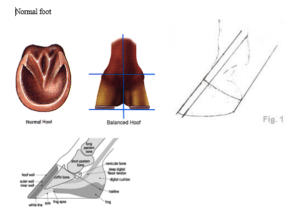 The heel is parallel to the toe.
The heel is parallel to the toe.
The heel is ~1/3 the length of the toe.
The frog and walls are weight bearing. The sole is not. The sole should be “cupped” versus flat (able to hold water if held sole pointing up).
The heels are wide spread. The frog width is at least 2/3 of the frog length.
The coronary band is parallel to the ground.
A line drawn through the middle of the cannon bone (from the side) extends through the heel region (not behind it).
On a radiograph, the dorsal surfaces of P2 and P3 are aligned.
Underrun heels
The dorsal hoof wall should be parallel the heels. If the heels are less upright than the toe, they are considered underrun.

A line drawn through the middle of the cannon bone should end in the heel region but not behind the heels.
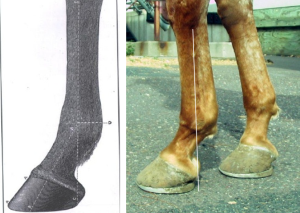
If the site where the heel touches the ground is too far forward, the forces impacting the heel region are not well dissipated and the navicular bone and related structures absorb more direct force.
Therapy: Trim the heel to the widest part of the frog. Provide support via shoe (heel tubules will keep growing in the same direction so they need to be “re-started”)
Broken back hoof-pastern axis
With a broken back hoof-pastern axis, P2 and P3 are not aligned but P2 is more vertical. This tends to accompany long toes (too long between trims) and/or underrun heels. This conformation places extra weight on the navicular bone, rather than on the digital cushion.
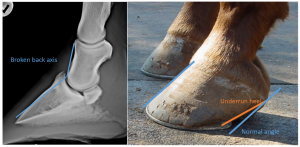
Therapy: Trim more frequently (at least every 4-6 weeks in summer, 6-8 weeks in winter) and/or elevate heels with pads and/or shoes.
Broken forward hoof-pastern axis
With a broken forward hoof-pastern axis, P3 is more vertical. Heels are vertical and long. This occurs in club footed animals and with P3 rotation secondary to laminitis. This conformation places more stress on the coffin joint, leading to synovitis and arthritis.
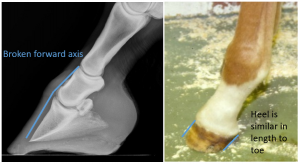
Therapy: Inferior check desmotomy to realign the hoof-pastern axis, combined with heel trim.
Medial-lateral imbalance
Often, one side of the hoof grows faster than the other. This leads to uneven weight bearing and more trauma to one side of the hoof. Chronic or severe issues predispose a horse to collateral ligament damage (sprain). Evaluating the coronary band (is it parallel to the ground?) and radiographs can identify this imbalance. On a radiograph, we often draw a line through the vascular channels as the bone below it should be symmetrical from side to side while an uneven stance can change the balance at the joint level.
Chronic imbalance will also lead to calcification of the collateral cartilages as they try to strengthen themselves.
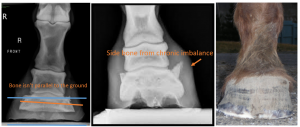
Therapy: More frequent trimming (at least every 4-6 weeks in summer, 6-8 weeks in winter). Monitor coronary band.
Flat sole
The horse should not be weight bearing on the solar surface. The sole be thin and flexible. This means it will transmit pressure to the sensitive laminae and weight bearing on a rock or dirt clod will be painful. The walls and frog should be the primary weight bearing structures.
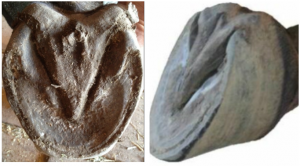

Contracted heels and sheared heels
Heels tend to be narrow with pain. If a horse has heel pain, he doesn’t put weight in the heel region and the heels aren’t encourage to spread apart. Narrow heels or narrow frogs are a big warning sign that the horse has chronic heel pain. Look for signs of navicular syndrome. Treatments are available to encourage widening; however, treatment is often short-lived if the heels stay painful.
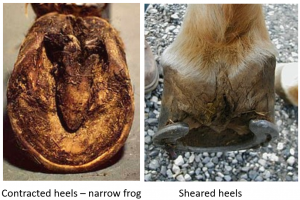
Heels can also be sheared – each at a different height. This tends to be very painful. This can be associated with hoof imbalance.
Therapy : pain relief, larger shoes with wide rim to encourage heel spreading, floating a heel (trimming one side more) to let the heel sink back down to the normal location (note that this is controversial).
Shoes
Shoes come in a variety of shapes and sizes. Generally, a shoe needs to be at least as big as the foot. A shoe that is too small will start to cause solar pain and prevent normal hoof expansion.
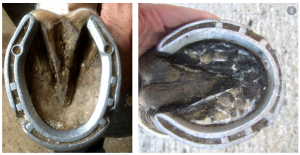
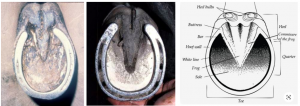
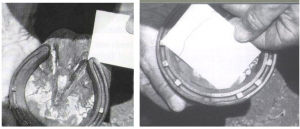
A shoe that is oversized tends to come off accidentally as the horse (or another horse) steps on the outside edge. It is tempting to ensure there is no overhang. Shoes do need changing. If left on too long, they will become too small.
Key Takeaways
Lame horses may benefit from a good trim or a more frequent trimming. Check each foot for
- hoof-pastern axis issues (broken back, broken forward)
- medial-lateral imbalance
- flat soles (weight bearing on the sole vs the wall)
- underrun heels
- sheared heels
- contracted heels
Check the shoe for uneven wear and fit
Resources
Manual of Clinical Procedures in the Horse Ch 32
cutting of a ligament

